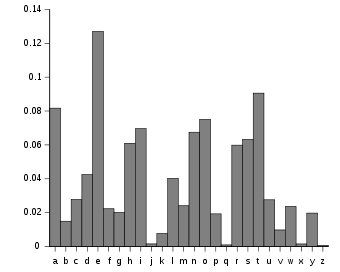The Caesar Cipher was named after Julius Caesar (100 B.C. – 44 B.C). He would use the cipher for secret communication (protect messages of military significance). The Caesar Cipher is a substitution cipher. Originally, Julius Caesar would use a shift of three to encrypt/decrypt a message. The Caesar Cipher encrypts a message using an affine function : f(x) = 1x + b.
-
Firstly, each character of the initial text (message to encrypt) is converted in a number from 0 to 25, corresponding to its position in the Latin alphabet which contains 26 letters --> (a = 0, b = 1 ... z = 25 ).
-
Then, each number obtained is transformed by an affine function (f(x) = 1x + b). "x" is representing the number while "b" is defined during the encryption. "b" is the key used to decrypt the final message.
-
If we take all the images and put them in a list, we obtain n numbers corresponding to n charcaters of the initial text. The next step consists in finding the values of mudulo 26 of each number. (Modulo means remainder)
Example : Modulo 4 of 19 is 3 because 15 = 4 * 4 + 3 In the other hand, modulo 26 of 26 is 0 because 26 = 26 * 1 + 0
-
Therefore, we cobtain a new list with n element, each between 0 and 25 both included. All these numbers are converted in letters of the Latin Alphabet using the tables below.
-
We finally create the final message by putting all the letters side by side.
Steps 1 and 4 can be done with these tables :
| A | B | C | D | E | F | G | H | I | J | K | L | M |
|---|---|---|---|---|---|---|---|---|---|---|---|---|
| 0 | 1 | 2 | 3 | 4 | 5 | 6 | 7 | 8 | 9 | 10 | 11 | 12 |
| N | O | P | Q | R | S | T | U | V | W | X | Y | Z |
|---|---|---|---|---|---|---|---|---|---|---|---|---|
| 13 | 14 | 15 | 16 | 17 | 18 | 19 | 20 | 21 | 22 | 23 | 24 | 25 |
-
If an attacker knows that the message has been encrypted using Caesar Cipher, he can try all shifts (b values from 1 to 25) to decrypt the message. This is called the bruteforce method.
-
We can also use frequency analysis to decrypt the message as each letter is encrypted with the same algorithm and the most common letters in english are :
- Message to encrypt : ZATTACKZ
- Shift used : 4 (f(x) = 1x + 4)
- That means that b = 4
Using the above tables, ATTACK can be written as : 25 0 19 19 0 2 10 25 Images of each number :
- f(25) = 29
- f(0) = 4
- f(19) = 23
- f(2) = 6
- f(10) = 14
The new list is : 29 4 23 23 4 6 14 29
Using the modulo 26 method, we obtain:
- Mod(29,26) = 3
- Mod(4,26) = 4
- Mod(23,26) = 23
- Mod(6,26) = 6
- Mod(14,26) = 14
The final message is 3 4 23 23 4 6 14 3 and using the tables again, we convert them in the encrypted message :
DEXXEGOD
ZATTACKZ is encrypted with the function x + 4 and becomes DEXXEGOD.
- Message to decrypt : DEXXEGOD
- Shift used : 4 (f(x) = 1x - 4)
- That means that b = -4
Using the above tables, DEXXEGOD can be written as : 3 4 23 23 4 6 14 3 Images of each number :
- f(3) = -1
- f(4) = 0
- f(23) = 19
- f(6) = 2
- f(14) = 10
The new list is : -1 0 19 19 0 2 10 -1
Using the modulo 26 method, we obtain :
- Mod(-1,26) = 25
- Mod(0,26) = 0
- Mod(19,26) = 19
- Mod(2,26) = 2
- Mod(10,26) = 10
The final message is 25 0 19 19 0 2 10 25 and using the tables again, we convert them in the encrypted message :
ZATTACKZ
DEXXEGOD is decrypted with the function 1x - 4 and becomes ZATTACKZ.
This is called the bruteforce method.
- Message to decrypt : DEXXEGOD
Using the above tables, DEXXEGOD can be written as : 3 4 23 23 4 6 14 3
a is a number between 0 and 25. (a = 0 would mean the message is already decrypted)
Using the function f(x) = Mod(1x + a, 26) :
We can get all these results :
| a | Decrypted text |
|---|---|
| 1 | fgzzgiqf |
| 2 | ghaahjrg |
| 3 | hibbiksh |
| 4 | ijccjlti |
| 5 | jkddkmuj |
| 6 | kleelnvk |
| 7 | lmffmowl |
| 8 | mnggnpxm |
| 9 | nohhoqyn |
| 10 | opiiprzo |
| 11 | pqjjqsap |
| 12 | qrkkrtbq |
| 13 | rsllsucr |
| 14 | stmmtvds |
| 15 | tunnuwet |
| 16 | uvoovxfu |
| 17 | vwppwygv |
| 18 | wxqqxzhw |
| 19 | xyrryaix |
| 20 | yzsszbjy |
| 21 | zattackz |
| 22 | abuubdla |
| 23 | bcvvcemb |
| 24 | cdwwdfnc |
| 25 | dexxegod |
The only text that makes sense is zattackz so we can deduce that the key is 21 (25 - b = 21).
DEXXEGOD is decrypted with the function f(x) = 1x - 4 or f(x) = 1x + 21 and becomes ZATTACKZ.
